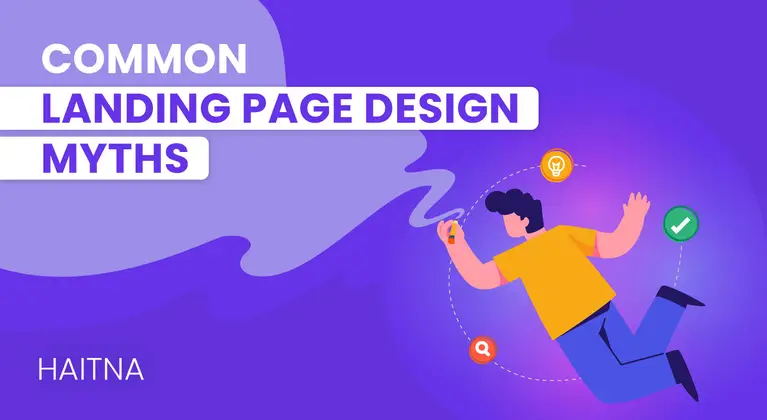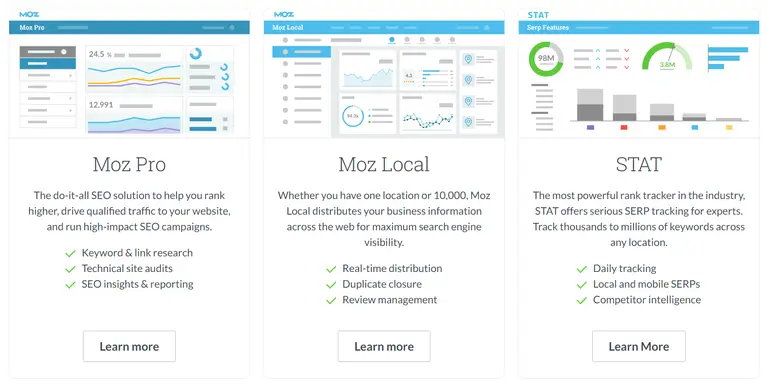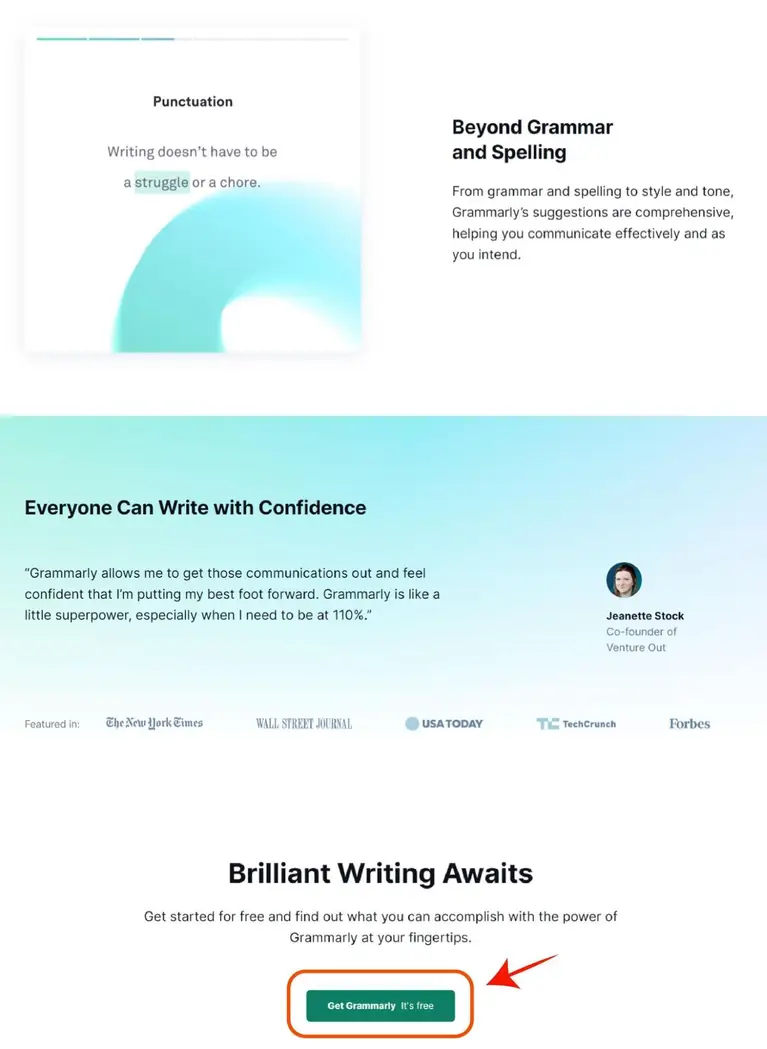
Common Myths About Landing Page Design Debunked
Landing pages come with a lot of misconceptions, most of which are unfounded. Several people believe different things about landing pages, which has given rise to myths.
As a business owner or a marketer, you should understand how to use landing pages for your business.
You can leverage landing pages to get more brand reach and awareness. It gives you more insights into avoiding them and using landing pages better. But to do that effectively, you need to understand some of the myths surrounding landing pages.
Let's talk about the most common myths about a landing page and why you should ignore them.
7 Common Landing Page Myths You Should Ignore
1. Using Only A Few Landing Pages Is Enough
Perhaps one of the most common topics around landing pages is that your website only needs a few of them. While this might be true if you're just starting, the more you grow, the more landing pages you will need.
The below screenshot shows a startup site with only 4-5 landing pages.

As the number of services and demographics increases, you need more landing pages. Landing pages can funnel traffic to the "money pages" of your website.
The Reality
Any digital marketing agency will tell you that the more diverse your landing page portfolio is, the more people you'll attract. With enough research, you'll be able to capture most types of people with different landing pages.
- Use Google Analytics to determine the categories of people visiting your website. You can then work on creating powerful landing pages.
- Unbounce is a wonderful tool when it comes to building landing pages. It is easy to use, even for first-timers to web design.
- OptimizePress is a boon for WordPress users who want to build unique landing pages.
2. Duplicate Landing Pages Improve Conversions
Another myth that has been making the rounds is that duplicate landing pages are okay. And some businesses use it to create multiple pages in the following way.

In theory, each of these landing pages funnels different types of leads for the website. But this is not how landing pages work, especially ones that are copies of each other.
The Reality
Copying landing pages in the hopes that it will net you more traffic is never going to work.
Search engines are tuned to avoid duplicates of the same page, meaning users will not see them on the results. The entire website can sometimes be penalized by withholding them from search results.
- The design and colors are the only aspects of your landing page you can adapt to a new page. Copying content can have seriously negative results, even being blocked from results.
- Content plagiarism is a serious problem; different pages with the same content can amount to spamming.
- Use tools like Copyscape to ensure that you don't have plagiarized content on your website.
3. Having A Good Amount Of Text Is Bad
Something that has come up of late is that less content is better for producing results for landing pages. This couldn't be further from the truth.
While it is a good idea not to cram users with walls of text - you need to give them enough content to read. There also needs to be enough content to ensure proper SEO.
The Reality
A new myth is that short copy always triumphs over long-form content. But regardless, it is false; you should never have a landing page with thin content. The penalty for thin content is far greater than having too much content on the page.
- The more context you can give your readers, the more qualified your leads will be. It's all about getting high-quality leads.
- To find the right length for content on your landing page, A/B testing can help. Google Optimize can help you test various aspects by comparing each landing page’s performance.

- Ensure you've included the right amount of keywords in the content. SEMrush can help you get it right with keywords.
4. Start With Best Practices Of Another Company
Some companies mistake following what works for another brand in the same niche. As the myth goes, copied landing pages can replicate the original's success. This is far from the truth and does not produce the expected results.
The Reality
People should understand that each business is unique. What works for one company may not work for the other. Reverse engineering their successful landing page will not work for your brand.
They might have different goals, targets, or demographics. While it is good to have takeaways, copying the whole landing page is never a good idea.
For example, the screenshot below shows the Moz tool's landing page.
Although several other SEO tools offer similar solutions, copying the same will create a negative impression among the audience and search engines.

- Rather than copying an entire landing page, this can help improve your success rate with them over time.
- Get a lot of samples from different competitors and not just one. This can help you get the best parts of several different landing pages and increase the chances of your success.
- Testing different landing pages can help you choose the right one for your website.
5. Conversions Are The Only Thing That's Important
Some marketers believe conversions are the only metric to keep track of with landing pages. This is simply short-sighted because landing pages are so much more than that.
To limit the effect of landing pages to just one aspect would be underestimating its benefits.
The Reality
Conversions are important, but they're not the only thing that makes a difference. A good landing page can lead people to more services on your website.
You might not get a buyer on the same landing page, but they might opt for another service on your website.
- Sometimes creative landing pages are highlighted in articles. A good example of this type of post is this one from HubSpot about the Best Landing Pages. Here, Hubspot is trying to help its audience rather than convert them into customers.

- Landing pages are more about just conversions. You can get increased brand awareness for your business which is a huge plus.
- Even after you've converted a user to a customer, landing pages can help. It can keep them interested in your other products.
6. CTAs Should Always Be Above The Fold
A popular myth about landing pages is that you should always use call-to-action phrases and buttons above the fold. The fold is a part of the website that is visible without having to scroll lower.
The Reality
Of all the myths, this has been the most difficult to bust over the years. Simply saying that CTAs must be visible at first glance is an uninformed opinion. Studies have shown that if the content is good, CTAs are also effective when placed below the fold.
- There is no basis for this myth that people only click on CTAs above the fold. If you have proper content, you will have people interacting with your landing page through CTAs.
For example, see the screenshot below showing Grammarly’s landing page with CTA at the bottom.

- Not all CTAs are of the same size. You can include shorter CTAs below the fold, and people will still click on them.
- Buttons and other graphical CTA elements can also be located lower. Most landing pages have buttons lower on their page.
7. Landing Pages Should Have All Information
A landing page is used to give an abstract of what your services are capable of. Even today, marketers think that a landing page should have detailed information about your business.
This simply does not work because the function of a landing page is not disseminating information.
The Reality
One of the most common myths about landing pages is that they should have all the information. The truth is that this is not true. While you should have everything available, it is important to understand that you don't need to have too much on each page.
- Too much information on the page can confuse readers, leading them to click away. Thus, having individual landing pages like the screenshot offers the audience a better user experience.

- The key to enticing landing pages is that the copy must be appealing and tight. It's okay to be creative and not make it all about the metrics.
- Create content that talks about how effective what you're providing is for the user. Keep the numbers and facts to another page.
Landing Page Myths / Mistakes - FAQs
1. What Are Some Of The Popular Myths About Landing Pages?
There are many myths about landing pages that we've detailed in this article. Most of them have a limited number of landing pages, only using conversion rates and CTA placement.
2. Why Do Landing Page Myths Become Popular?
These myths get around quickly because people don't take the time to read up on them. If marketers did enough research, they'd find that most of these myths are false.
3. How Can I Avoid Falling Into Landing Page Myths And False Flags?
This article can give you important insights into popular myths about landing pages. The key is not understanding that doing the research yourself is always better than relying on data from another source. At the very least, ensure that the source is independently verified.
Key Takeaways
- Do your research on popular landing page myths or facts before making a decision.
- Ensure that you use landing pages to the best of your judgment.
- Read up on popular marketing resources online before you put them into practice.
- Ignore the myths that we have listed in this article. They have all been proven to be false.
ABOUT THE AUTHOR:
Bhavika Juneja

Bhavika has worked on marketing projects for more than 10 years and can help with web design, app development, and other services. She has a passion for inspiring people to achieve their full potential, and she is doing that by helping businesses grow. She is a marketing consultant, with the expertise and experience to help you reach your goals.
ABOUT THE AUTHOR:
Bhavika Juneja

Bhavika has worked on marketing projects for more than 10 years and can help with web design, app development, and other services. She has a passion for inspiring people to achieve their full potential, and she is doing that by helping businesses grow. She is a marketing consultant, with the expertise and experience to help you reach your goals.
Related Post
How to Rebrand Your Business Without Losing SEO?